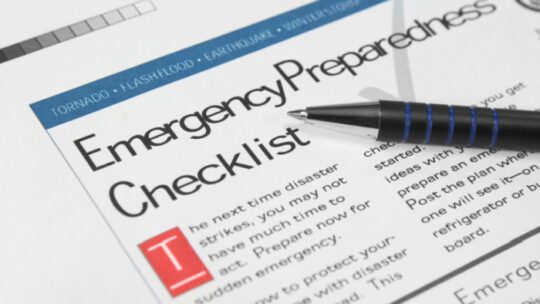
This summer brought some of the worst natural disasters the country has seen in recent times, from wildfires to floods and smoke coating major cities in a filter of orange. And hurricane season is only beginning.
In honor of the upcoming National Preparedness Month in September, PRNEWS decided to take a look at crisis from a climate change point of view.
From a communications perspective, adequate preparation for climate-related emergencies is of extreme importance. This is true for every industry, business and organization, no matter the size.
“The last thing you want is to be caught flat-footed, unprepared, scrambling during a major climate-related disaster where lives are at stake,” says Alex Frank, Co-Principal, Hastings Group Media.
“Communications to your audience, whether internal or [external], must be accurate, truthful, and most importantly, timely. Seconds matter.”
Brainstorm Scenarios Before Disaster Strikes
According to Lisa Ann Pinkerton, Founder and CEO, Technica, (and according to scientific data) when it comes to the climate crisis, things are going to get worse before they get better. Thus, organizations and municipalities have a responsibility to take measures to help people adapt, prevent and prepare.
“Organizations have a responsibility to understand that once-in-a-lifetime moments might happen on their watch with elements that will be seasonal, such as heatwaves, flooding, and other extreme weather events,” Pinkerton says.
She suggests organizations start by outlining all the different crisis scenarios that could happen and plan for addressing them.
“Some of them will be once-in-a-lifetime moments; others will be seasonal like wildfires or heat waves,” she says. “In the plan, include the people in the chain of command, what to do if it happens on a weekend, contact information, general talking points, steps to take within the first 24 hours, etc.”
Next, Pinkerton says to brainstorm the types of signals you could receive from the community (weather forecasts, employees, etc.) that could be red flags that a crisis is on the horizon.
“[Each crisis plan should also] organize a media campaign to address the situation with reverence and respect to the people affected.”
Learning from Peers
New York City discovered this the hard way in early summer when wildfire smoke engulfed the Big Apple, leaving the air dangerous and toxic to breathe, with little to no warning or safety guidance to the general public.
Frank suggests that because wildfire smoke is a recurring issue in other parts of the country, the city could reach out and see what those municipalities do in such situations.
“With climate change and extreme weather, areas that previously thought they would not have to respond or prepare for certain types of disasters, are now finding out that the new normal is far from normal,” he says.
“That means areas like the Northeast and Mid-Atlantic should have communications protocols on the books for climate-related events such as wildfire, extreme heat, drought, and other previously unlikely extreme weather events.”
Frank notes that many states and cities post climate-related disaster protocols on their websites.
“It's important that you familiarize yourself with specific protocols for extreme weather events, because often you won't have time in the moment to figure it out on the fly.”
Timing is Everything
As most communicators know, time is of the essence in every crisis situation. Some cases may allow for wait time, but for natural disasters more communication is never enough. It’s better to be safe than sorry.
“If the predicted flooding turns out to be not nearly as bad as the forecast, so what. There's nothing wrong with being prepared and cautious,” Frank says. “It's important that you communicate threats and protocols on a timely basis. If you're wondering whether it's too soon to say something…it's never too soon. But being too late has devastating and deadly consequences.”
Frank also instructs putting together a push-notification list of emergency alerts from local, regional and state sources to stay on top of things.
“Almost every municipality or government agency has an emergency alert system, and the last thing you want is to miss a timely climate-related alert,” he says.
“Have your communications protocols for extreme weather events ready to go in a shared folder, easily accessible to anyone responsible for communicating to the general public. And never assume people already know.”
Governments, Municipalities Must Own Their Media
John Guilfoil, Principal Owner, JGPR, works with many municipalities on crisis communication plans. He sees a shift in their realization that they can no longer depend on the local news to deliver alerts during emergencies.
“I think municipalities have slowly begun to realize that the local community newspaper is not there to bail out their lack of public communication anymore,” Guilfoil says. “One of the biggest consequences we’ve seen from the homogenization and corporatization of community news is that a lot of these small newspapers are completely gone. It’s not even that the newsrooms have shrunk anymore. It’s that the news rooms have disappeared.”
Guilfoil says that municipalities need to create modern, news-driven websites, mobile apps and integrated social media communications—everything that a mid-sized business would have to communicate with its customers.
Municipalities should be able to send push notifications to their residents, he says. “They can get the Red Sox scores pushed onto my phone. Why can’t I get urgent information from my city or town? The answer is you can, but we need to accept responsibility for doing it.”
Guilfoil says it's a philosophical shift—the realization of the government to assume responsibility for producing owned media and communicating with the public on a day-to-day basis to fill the void of community news. And that responsibility will lie with the public information officers and PR departments.
“Government needs to take the people who do public relations—public information officers—very seriously,” he says. “We teach that public relations is a function of management in a well-run business. Well, public relations and public information are a function of management in a well-run government as well.”
Nicole Schuman is senior editor for PRNEWS. Follow her @buffalogal
